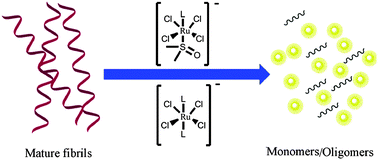Inhibitory effects of NAMI-A-like ruthenium complexes on prion neuropeptide fibril formation†
Abstract
Prion diseases are a group of infectious and fatal neurodegenerative disorders caused by the conformational conversion of a cellular prion protein (PrP) into its abnormal isoform PrPSc. PrP106–126 resembles PrPSc in terms of physicochemical and biological characteristics and is used as a common model for the treatment of prion diseases. Inhibitory effects on fibril formation and neurotoxicity of the prion neuropeptide PrP106–126 have been investigated using metal complexes as potential inhibitors. Nevertheless, the binding mechanism between metal complexes and the peptide remains unclear. The present study is focused on the interaction of PrP106–126 with NAMI-A and NAMI-A-like ruthenium complexes, including KP418, KP1019, and KP1019-2. Results demonstrated that these ruthenium complexes could bind to PrP106–126 in a distinctive binding mode through electrostatic and hydrophobic interactions. NAMI-A-like ruthenium complexes can also effectively inhibit the aggregation and fibril formation of PrP106–126. The complex KP1019 demonstrated the optimal inhibitory ability upon peptide aggregation, and cytotoxicity because of its large aromatic ligand contribution. The studied complexes could also regulate the copper redox chemistry of PrP106–126 and effectually inhibit the formation of reactive oxygen species. Given these findings, ruthenium complexes with relatively low cellular toxicity may be used to develop potential pharmaceutical products against prion diseases.

- This article is part of the themed collection: Alzheimer's Research Month 2016

 Please wait while we load your content...
Please wait while we load your content...